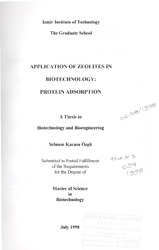Please use this identifier to cite or link to this item:
https://hdl.handle.net/11147/3907Full metadata record
| DC Field | Value | Language |
|---|---|---|
| dc.contributor.advisor | Ülkü, Semra | - |
| dc.contributor.author | Özgü, Şebnem Karasu | - |
| dc.date.accessioned | 2014-07-22T13:52:38Z | - |
| dc.date.available | 2014-07-22T13:52:38Z | - |
| dc.date.issued | 1998 | - |
| dc.identifier.uri | http://hdl.handle.net/11147/3907 | - |
| dc.description | Thesis (Master)--Izmir Institute of Technology, Chemical Engineering, Izmir, 1998 | en_US |
| dc.description | Includes bibliographical references (leaves: 41-45) | en_US |
| dc.description | Text in English; Abstract: Turkish and English | en_US |
| dc.description | vi, 64 leaves | en_US |
| dc.description.abstract | Recovery of proteins from vanous culture broths is a complex engmeenng problem, involving multi-step schemes that lead to significant loss of the desired bioproduct by conventional methods. The bioproduct is not only present in very low concentrations, but also it is subject to chemical/enzymatic degradation. An alternative cost-effective method for recovery of proteins in a highly purified form may be through adsorption, which is a separation technique based on specific and reversible binding, with the use of zeolites that have favorable adsorption characteristics over the other adsorbents. Protein adsorption characteristics of a natural zeolite (clinoptilolite from Turkey) and a synthetic (3A) zeolite were determined through various experiments, altering parameters as pH (range 3.5-6), the amount of zeolites used for adsorption (0.01-0.05 g/ml) and the initial protein concentration (0.01-0.1%). Within the concentration and pH ranges studied, the adsorption capacity of the zeolites was around 50 mg protein/g zeolite. For natural zeolite, approximately 98% was adsorbed within the first 2 minutes, while for the synthetic zeolite, 70% was adsorbed within the first 15 minutes. Uptake diagrams were obtained, adsorption isotherms were determined and Langmuir method was used to describe the isotherms. Desorption was also investigated after treating the zeolites with salt and acid, but further work is necessary for obtaining better recovery. It can be concluded that clinoptilolite is capable of adsorbing proteins in a short time. This study may be the preliminary step, followed by further laboratory work and necessary scale-up experiments, towards the use of zeolites in the recovery of proteins in industry as an alternative to conventional methods. | en_US |
| dc.language.iso | en | en_US |
| dc.publisher | Izmir Institute of Technology | en_US |
| dc.rights | info:eu-repo/semantics/openAccess | en_US |
| dc.subject.lcc | TP28.65.P76 .O94 1998 | en |
| dc.subject.lcsh | Proteins--Biotechnology | en |
| dc.subject.lcsh | Zeolites--Absorption and adsorption | en |
| dc.title | Application of Zeolites in Biotechnology: Protein Adsorption | en_US |
| dc.type | Master Thesis | en_US |
| dc.institutionauthor | Özgü, Şebnem Karasu | - |
| dc.department | Thesis (Master)--İzmir Institute of Technology, Chemical Engineering | en_US |
| dc.relation.publicationcategory | Tez | en_US |
| dc.identifier.wosquality | N/A | - |
| dc.identifier.scopusquality | N/A | - |
| item.openairecristype | http://purl.org/coar/resource_type/c_18cf | - |
| item.languageiso639-1 | en | - |
| item.openairetype | Master Thesis | - |
| item.grantfulltext | open | - |
| item.fulltext | With Fulltext | - |
| item.cerifentitytype | Publications | - |
| Appears in Collections: | Master Degree / Yüksek Lisans Tezleri | |
Files in This Item:
| File | Description | Size | Format | |
|---|---|---|---|---|
| T000105.PDF | MasterThesis | 16.44 MB | Adobe PDF |  View/Open |
CORE Recommender
Page view(s)
370
checked on Mar 31, 2025
Download(s)
138
checked on Mar 31, 2025
Google ScholarTM
Check
Items in GCRIS Repository are protected by copyright, with all rights reserved, unless otherwise indicated.